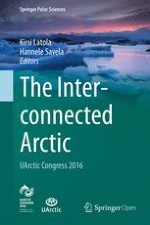Open Access 2017 | Open Access | Buch

The Interconnected Arctic — UArctic Congress 2016
herausgegeben von: Kirsi Latola, Hannele Savela
Verlag: Springer International Publishing
Buchreihe : Springer Polar Sciences
Open Access 2017 | Open Access | Buch

herausgegeben von: Kirsi Latola, Hannele Savela
Verlag: Springer International Publishing
Buchreihe : Springer Polar Sciences
This book is open access under a CC BY License. This book presents the most current research results and knowledge from five multidisciplinary themes: Vulnerability of Arctic Environments, Vulnerability of Arctic Societies, Local and Traditional Knowledge, Building Long-term Human Capacity, New Markets for the Arctic, including tourism and safety. The themes are those discussed at the first ever UArctic Congress Science Section, St. Petersburg, Russia, September 2016.
The book looks at the Arctic from a holistic perspective; how the environment (both marine and terrestrial) and communities can adapt and manage the changes due to climate change. The chapters provide examples of the state-of-the-art research, bringing together both scientific and local knowledge to form a comprehensive and cohesive volume.